Another day, another flight and another airport. Endless lines and security checks but at least being a frequent flyer on Garuda I can sit in a quiet lounge here in Pontianak, a city on the equator on the west coast of the island of Borneo and use the opportunity to write some words to our loyal supporters.
I just came back from visiting the Sintang Orangutan Center and the team there. So good to catch up with Father Jacques, already more than 50 years serving and supporting the Dayaks of West Kalimantan and still going strong. Jessie, one of our first baby sitters will got married the 9th of December, many new staff joined the project to deal with the new release site and with the upcoming Jerora forest school. There is so much to tell at the end of 2017 that I will try to divide it in chapters, beginning with our first orangutan release in the Betung Kerihun National Park.

The river as well as our basecamp inside the national park are called Mentibat. It takes 7 hours by boat over ever cleaner and faster streaming rivers to reach the basecamp within the national park. Going up the Mentibat river from our basecamp we then enter the smaller tributary called the Rongun River that leads to the release area passing by various fast and furious rapids. It takes our skilled boatmen only 20 minutes by longboat to reach the area where they moor the boat after which it still another tough 30 minutes walking to the actual release site in the jungle. Here are some pictures of the release that took place last month and that can tell so much more than paragraphs of words:
Chapter 1:
The Release
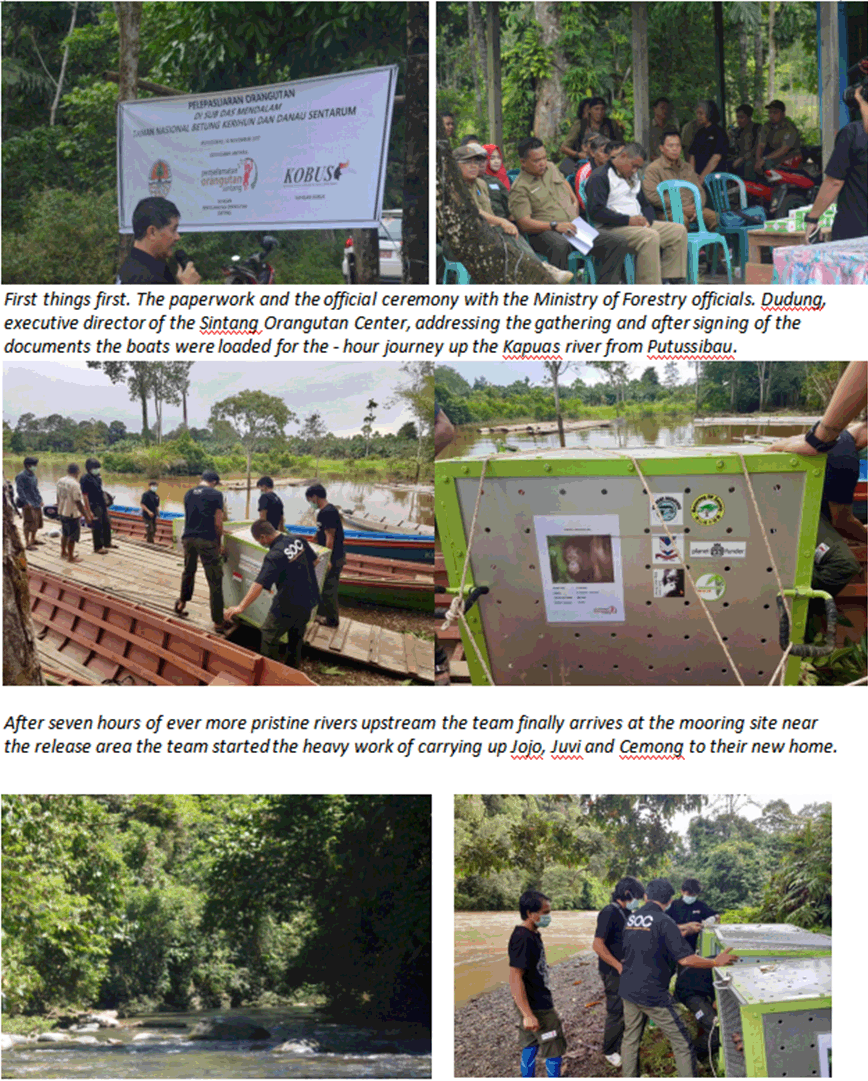
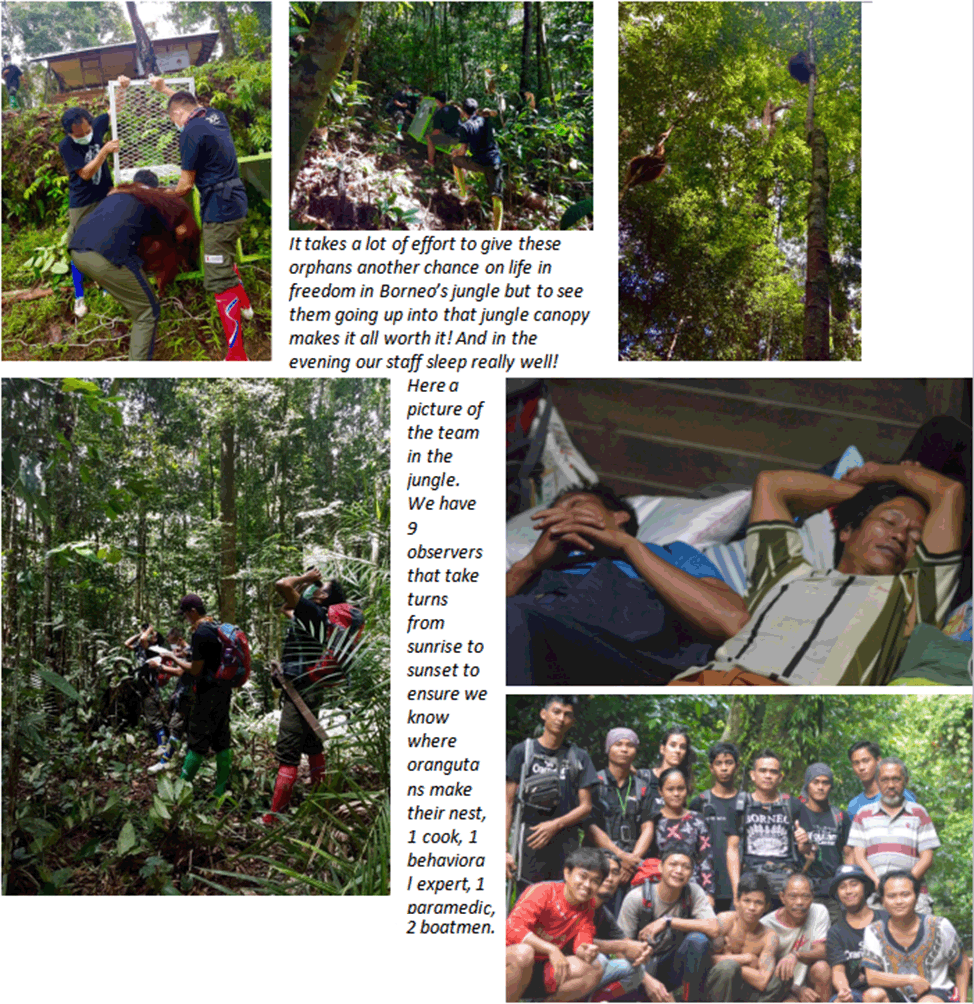
The Forest
It took a very long time to ensure that this release area was going to be suitable for the release of orangutans. First of all we had to make sure there was not wild orangutan population present where the introduction of rehabilitant orangutans could have disturbed the balance between the carrying capacity of the forest and the number of orangutans that can live there and to prevent potential release of diseases into a natural population of wild orangutans which would have the opposite effect of helping orangutans survive.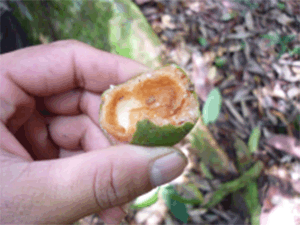
From previous inventories by the Ministry of Forestry and various international parties we knew that there were no.
orangutans seen in the area and also that the composition of the forest was ideal for orangutans in terms of edible fruits, twigs and leaves. And sure enough the first reports on how our first three ladies are doing in the forest completely support it. Already within the first five days of freedom they are utilizing 23 different known orangutan fruit species that we were able to determine and about 80 more species of which we have marked the trees and sampled leaves and fruits for later identification.
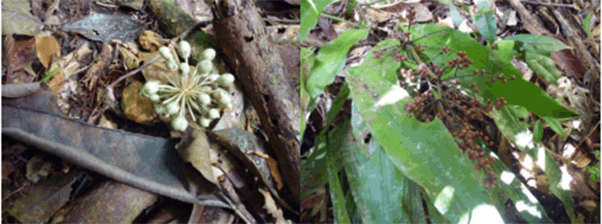
Some samples of food items already utilized by Jojo, Juvi and Cemong.
Secondly the location needs to be secure. What makes a forest secure? First of all the legal status. We worked long and hard with the Ministry of Forestry to get all the legal paperwork in place and especially the national park management and the regional nature conservation office have been great in getting it all done. As far as fire risks, the area with its high rainfall and relatively cool temperatures (24-25 Celsius, sometimes as low as 22) and its surrounding rivers also is at low risk. But then there is the most important factor and that is the influence of people. There are hunters, poachers, fishermen, wood thieves, gaharu seekers and people and companies that try to get their hands on the land despite protected status or importance of the area for other people around it or downstream.
The fast-flowing rivers with many rocks make it hard to steal the timber from the release area without making a permanent road access system. When we tried initially to survey the area there many times that our people ended up soaking wet being unable to get the boats over the rapids. But now we have two very skilled local boatmen. Before the actual release, we had many contacts with the nearby Dayak tribes, especially the nearby village of Mendalam. I visited them already 10 years ago and was impressed how the Dayak culture of doing things together through consensus still worked there. But they also had huge problems with oil palm companies trying to enter their areas (see one of my earlier blogs) that tried to disrupt that unity. So, having lost forest to outsiders some people come hunting in the national park with their locally made rifles or look for the precious gaharu wood (Aquilaria malaccensis) from which the world’s most expensive Oud perfume is made. But by hiring many young men from the nearby Mendalam village to work with us for the orangutans the other villagers agreed not come in any more with their locally made guns and hunt for pigs there or put up snares.
A recent event improved the situation further. A small group of Dayaks had gone past the camp upriver to catch fish and had set up a small camp. Two persons, a father and son, stayed behind while the others left for a few days. Then the father seriously injured himself from an exploding jerry can with fuel. There was no way he could be evacuated so his son drifted with the fast-flowing water over the rapids and rocks to our basecamp to beg for help. Our boat immediately headed upriver with doctor Jati and our local staff. Jati gave first aid and the father was evacuated and survived his serious burns. That action really made our relationship with the villages even stronger. In the discussions they had in the Mendalam village afterwards, the villagers agreed that this was a sign that the “fine beings” of the forest did not agree with them entering the new orangutan area. There are still some gaharu seekers from the nearby Talis district seen sometimes but they are also told one by one that this area should be left to the orangutans. Also 14 of the staff that are monitoring the released orangutans are recruited from the nearby villages and this creates also a lot of goodwill for the project. These local recruits have now become the ambassadors of the orangutan and nature conservation project to the other local people.
A good sign is that the forest still has lots of wildlife in it. An important indicator is the presence of the Murai bird, a bird that is extremely popular in Indonesia because of its singing. Poachers bring USB sticks with various of their songs on them to entice the wild birds to come near and sit on some strategically placed branches with bird glue so they can be easily captured. So their presence is an indicator that the area has at least not yet been heavily impacted by hunting and poaching.

The Murai bird in the release area and a crab eating macaque looking at the boat passing by on the river.
The Mendalam area also has a lot of naturally occurring sugar palms that we can develop for the local people to be tapped. Masarang can train them and also help them with the marketing of the palm sugar, especially now we just received the national award of the president of Indonesia as the best medium sized social enterprise of Indonesia which will increase the demand for Masarang palm sugar even more.
The orangutans are doing really well. Juvi makes the best nests and high in the trees. Cemong and Jojo like to share a nest at night. They are gradually exploring more of the area now already moving into higher areas up till 825 meters above sea level compared to the release location at 150 meter altitude. The work to observe them in the steep and muddy terrain with almost daily tropical rain showers is very hard. That is why we have a lot of staff so they can take turns. After all they have to be there at sunrise when the orangutans wake up and only can leave them once they have made their nest shortly before sunset. Those are long and exhausting days but the local Dayaks are the best suited for the job!
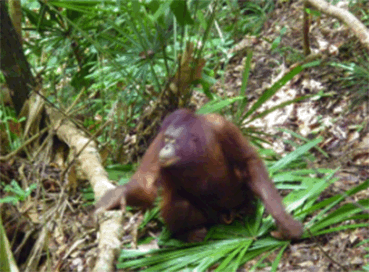 To end this first blog on the release in the Betung Kerihun National Park a picture of Cemong collecting fresh shoots of this Licuala understory palm and at the same time using the leaves to build a ground nest to play with. We can take these pictures because Cemong is still interested in people and still approaches us sometimes.
To end this first blog on the release in the Betung Kerihun National Park a picture of Cemong collecting fresh shoots of this Licuala understory palm and at the same time using the leaves to build a ground nest to play with. We can take these pictures because Cemong is still interested in people and still approaches us sometimes.
Willie Smits
Sintang/Pontianak
Leave a Reply